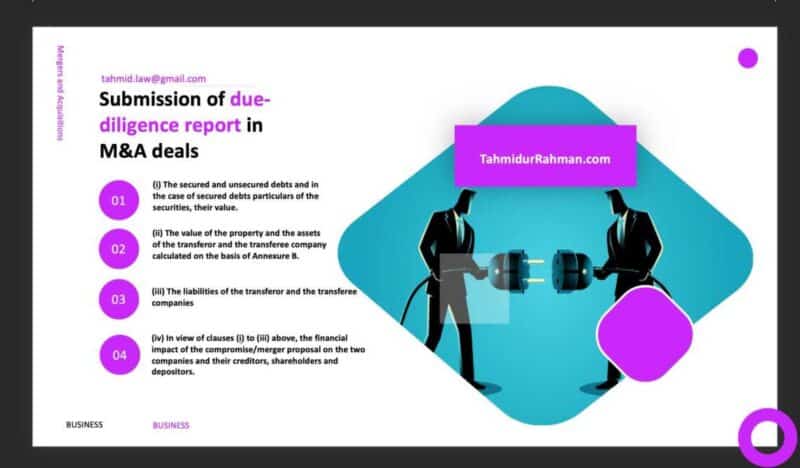Mergers and Acquisitions in Bangladesh – Efficient steps in 2023 – M&A Process

Tahmidur Rahman
Director and Senior Associate, TR Barristers in Bangladesh
27 Dec 2019
Updated in Jan 9, 2023
Our clients profit from a leading global M&A practice that has worked on more M&A transactions than any other law firm over the last 2 years. In TR Barristers in Bangladesh, our experience helps us to efficiently execute local and cross-border global transactions while helping you at all stages of the process and offering you cost-effective, realistic business solutions. This post explains in details about the mergers and acquisitions process in Bangladesh.
What are Mergers and Acquisitions?
Mergers and acquisitions ( M&A) refer to transactions which are combined in some way between two entities. While the use of mergers and acquisitions ( M&A) is synonymous, they come with different legal symbolic meanings. Two similar-size businesses unite in a merger to form a new corporate company.
On the other hand, an acquisition is when a larger enterprise acquires a smaller enterprise, thereby absorbing the smaller business. M&A transactions can be friendly or aggressive, depending on the board approval of the target firm. (Mergers and Acquisitions in Bangladesh)
Types of Mergers and Acquisitions (M&A) Transactions
1. Horizontal M&A
A horizontal merger occurs between two firms operating in related industries which may or may not be direct competitors.
2. Vertical M&A
A vertical merger takes place in the supply chain between a business and its supplier or a client. The business intends to shift up or down the supply chain, thus consolidating its role in the market.
3. Conglomerate M&A
This form of transaction is typically performed in different industries for purposes of diversification, and is between businesses.
Legal Framework of a Mergers and Acquisitions (M&A) Transactions in Bangladesh
Bangladesh does not have a specific or a single piece of legislation dealing solely with mergers and acquisitions. Instead there are various statutes and by-laws in Bangladesh that govern acquisitions and mergers.
The main laws are the Companies Act 1994, the Securities and Exchange Ordinance of 1969, the Bangladesh Securities and Exchange Commission Act of 1993, the Foreign Exchange Management Act of 1947, the Competition Act and the By-Laws rendered under those Statutes. Additionally , there are various rules that deal with particular aspects of mergers and acquisitions. For example,the Insurance Act 2010 for insurance companies and the Bangladesh Telecommunication Regulation Act 2001 for the telecommunication sector.
Step by Step process for Mergers and Acquisitions in Bangladesh
While contemplating game changing strategic transactions, companies regularly seek Counsel Law Partners to plan, negotiate and close their deals. As an integrated team, the mergers and acquisitions lawyers from our law firm work through the broad spectrum of practice areas involved in strategic M&A transactions.
Our mergers and acquisitions lawyers are committed to attaining the ambitions of our clients and offering innovative ideas and industry-focused legal advice. And here are the conventional steps by steps procedure of a mergers and acquisitions in Bangladesh:
Step 1: Proposal of a Merger
Any company proposing to carry out merger first have to get suitable resolutions passed by their Board of Directors. By passing the resolution, the Board of Directors will agree in principle, to proceed in accordance with such resolution.
During the planning stage of the merger, key executives in both merging entities’ supply chain should create dedicated integration, project management office, and steering committee teams with specific job descriptions, meeting cadence, and coordinated deliverables and status updates templates.
A timely, detailed organizational viewpoint can be introduced into a phase of M&A integration where there is a collective participation of the supply chain leadership.
This partnership becomes possible at all levels of the organizations work together during the integration process; however, the position of the operations and production staff varies depending on the phase.
The resolution passed may be treated as Price-sensitive Information (i.e. the information if published is likely to materially affect the price of securities of the company).
Step 2: Negotiations
After producing some of the target company’s valuation models, the acquirer should have sufficient information to allow him to ensure a fair offer; once the initial offer has been made, the two companies will discuss terms in more detail
Step 3: Due-Dilligence for the Merger
To enable Bangladesh Bank to consider the effectiveness of merger, the transferee company have to seek prior approval to commence financial and legal due-diligence of itself and also of that company they are intending to merge with.
Due diligence is a systematic procedure that starts when the offer is accepted; due diligence seeks to validate or correct the acquirer ‘s estimation of the target company’s worth by conducting a thorough evaluation and examination of any aspect of the target company’s operations – its financial results, assets and liabilities, clients, human resources, etc.
In order to seek the approval for due diligence the transferee company need to submit certain documents.
Documents:
- Credentials of the company (background, resources, net worth etc.) and
- Information about the team of Lawyers, Financial Advisors, Chartered Accountants, Valuers etc. for conducting due-diligence of the asset and liability of both the companies.
The transferee company have to ensure that none of the team members engaged in due diligence are actively dealing in shares or have any conflict of interest with either of the companies intending to merge together.
“Tahmidur Rahman Remura Wahid Parnters is Considered as one of the leading firms in M&A Law in Dhaka, Bangladesh”
Carpe Noctem Bangladesh
If you want to know everything about Share Transfer process in Bangladesh!
Step 4: Disclosure and Confidentiality
a)Disclosure
Disclosure plans are an important part of any agreement involving merger or acquisition (M&A), and it is no exception in Mergers and Acquisitions in Bangladesh. The disclosure schedules include details provided by the acquisition agreement — typically a list of relevant contracts, intellectual property, employee records, and other specific matters, as well as exceptions or conditions to the selling company’s comprehensive representations and warranties in the acquisition agreement.
An incorrect or incomplete disclosure plan may result in the selling company or its stockholders being infringed by the purchase agreement and potentially serious liability. Whenever a person/company intends to own, acquire or control 10% or more voting shares in a company listed on any stock exchange in Bangladesh, there is a mandatory obligation of disclosure. Meaning, both the companies are under an obligation to disclose information about the companies among themselves.
b)Confidentiality
However, there is also an obligation of confidentiality as well. Upon obtaining approval from Bangladesh Bank for conducting due-diligence, the transferee company shall submit an undertaking to Bangladesh Bank.
Such an undertaking confirms that all information, in particular all non-public domain information and documents etc. shall be kept strictly confidential. In addition, such confidential information shall not be disclosed to any person or organization unless advised by Bangladesh Bank or legally required or required to comply with the regulatory requirements. However, this confidentiality requirement does not apply for the due diligence team.
In Mergers and Acquisitions in Bangladesh, it is to be noted that the members of the due-diligence team will also be bound under the aforesaid undertaking to keep the information, document etc. confidential. In addition, the due-diligence team shall not demand any information/observations made by Bangladesh Bank in relation to the affairs and the business of concerned companies from the transferee or transferor companies.
Step 5: Due diligence report submission
Upon completion of the task of due diligence, the team will have to submit a copy of the report to Bangladesh Bank. (Mergers and Acquisitions in Bangladesh)
The due diligence report must include the following information:
- Debts that are secured and unsecured and in the case of secured debts particulars of the securities and their value.
- The value of the property and the assets of the transferor and the transferee company calculated.
- The seller’s M&A counsel also should endeavor to limit disclosures to lists of documents or matters rather than descriptions of the contents of documents or matters (such as requiring a list of pending litigation rather than a description of each pending lawsuit); again, this approach lessens the work involved in preparing the disclosure schedules.
- The liabilities of the transferor and the transferee companies.
- In view of the above clauses, the financial impact of the merger proposal on the two companies and their creditors, shareholders and depositors.
Step 6: Shareholders’ and creditors’ consent
The next step would be to prepare a scheme of merger by the transferor or transferee companies based on the due diligence report. The Board of Directors of the respective companies will have to pass a resolution in this regard.
While passing the resolution the scheme shall be considered as so drawn and then, in accordance to the provisions of Companies Act -1994, hold meetings of their respective members to consider and approve, the concerned scheme.
Step 7: Scheme Submission to Bangladesh Bank
Thereafter, an application will have to be submitted to Bangladesh bank by the transferee company. In addition to the application, a copy of the Scheme of merger/amalgamation, together with such other documents will have to be submitted.
Other documents include:
- Name, address and occupation of the Directors of the transferee company as proposed to be reconstituted after the amalgamation
- Details of the proposed Chief Executive Officer of the transferee company after the amalgamation.
- Post-merger Branch Plan, Technology Plan, Human Resource Plan and proposal to address Corporate Governance issues.
Information relevant for consideration of the scheme and the swap ratio including the following:
- Valuer Report explaining the method of valuation and the justification for it. If market value of shares has been considered in computation of swap ratio, the value so considered,
- Last three years annual report of each of the companies,
- Financial results, if any, published by companies covering the periods subsequent to the Annual reports
- Significant anticipated changes in service and products.
- Pro forma combined balance sheet of the transferee company as it will appear following the amalgamation,
Computation based on pro forma balance sheets of the following items:
- Tier I Capital
- Tier II Capital
- Risk weighted assets
- Gross and net Non-Performing Loans
- Ratio of tier I capital to risk weighted assets
- Ratio of tier II capital to risk weighted assets
- Ratio of tier I capital to total assets
- Ratio of total capital to risk weighted assets
- Ratio of gross and net NPLs to advances.
Any other information or explanation as sought by Bangladesh Bank.
If you want to know how to open a company in Bangladesh or about company formation click here!
- Step by Step Process of Registering a Company in Bangladesh
Here is a table outlining the process of mergers and acquisitions in Bangladesh:
| Step | Description | Relevant Law | Figures |
|---|---|---|---|
| 1. Pre-acquisition planning | The acquiring company conducts due diligence on the target company and develops a plan for the acquisition. | Companies Act 1994, Securities and Exchange Ordinance 1969, Bangladesh Competition Act 2010 | The acquiring company may need to engage legal, financial, and other advisors to assist with the planning process. The cost of these services may be significant. |
| 2. Negotiation and agreement | The acquiring and target companies negotiate and agree on the terms of the acquisition, including the purchase price and any conditions that must be met. These terms may be set out in a letter of intent or a term sheet. | Companies Act 1994, Securities and Exchange Ordinance 1969, Bangladesh Competition Act 2010, Contract Act 1872 | The purchase price may be paid in cash, securities, or a combination of both. The terms of payment may be negotiated between the parties. |
| 3. Regulatory approvals | The acquisition may need to be approved by regulatory bodies, such as the Bangladesh Securities and Exchange Commission (BSEC) and the Bangladesh Competition Commission (BCC). | Companies Act 1994, Securities and Exchange Ordinance 1969, Bangladesh Competition Act 2010 | The BSEC may require the acquiring company to make a public announcement of the acquisition and provide certain information to the market. The BCC may need to review the acquisition to ensure it does not result in a substantial lessening of competition. |
| 4. Shareholder approval | The acquisition must be approved by the shareholders of both the acquiring and target companies. This may require a vote at a general meeting of shareholders. | Companies Act 1994, Securities and Exchange Ordinance 1969, Bangladesh Companies Act 1994 | The shareholders of the target company may be entitled to receive compensation for their shares in the form of cash, securities, or other assets. The amount of compensation may be determined by the purchase price negotiated between the parties. |
| 5. Completion | The acquisition is completed and the target company becomes a subsidiary of the acquiring company. | Companies Act 1994, Securities and Exchange Ordinance 1969, Bangladesh Companies Act 1994 | The target company’s assets and liabilities are transferred to the acquiring company, and the target company’s shares are cancelled. The acquiring company may also need to register the acquisition with the relevant authorities, such as the Registrar of Joint Stock Companies and Firms. |
| 6. Integration | The acquiring company integrates the target company’s operations, including its employees, systems, and processes. | Companies Act 1994, Securities and Exchange Ordinance 1969, Bangladesh Labor Act 2006 | The integration process may involve restructuring, cost-cutting measures, and other changes to the way the combined company does business |

Step 8: Draft Scheme Examination
After receiving the draft Scheme, Bangladesh Bank will satisfy itself that the Scheme as proposed by the transferee company can be implemented successfully. In deciding such, Bangladesh Bank will consider various factors through examination of the scheme. The factors that may be considered are the capital of the merged entity, valuation of assets and liabilities, the impact on the profitability etc.
Step 9: Assets and liabilities valuation
It is upon the merging companies to mutually agree the valuation of the assets. Bangladesh Bank does not generally interfere in this regard except where there are reasons to believe that the valuation is not fair and reasonable. If mutual agreement is not possible in relation to certain items then any of the parties to the merger can seek advice of Bangladesh Bank.
The Bangladesh Bank plays the role of a mediator and help resolve the differences. In case the mediation fails, the Bangladesh Bank will decide the value and the decision of the Bank in this regard shall be binding. The cost of obtaining such advice will be borne by the transferor company.
In a case where mutual agreement has not been possible in relation to certain items for example:
(a) valuation of a particular asset
(b) classification of any advance
(c) determination of any liability or any like issue, the bank / financial institution, shall highlight those areas and seek advice of Bangladesh Bank.

Step 10: Transaction Price in Mergers and Acquisitions in Bangladesh
Again the transaction cost/price is a matter to be mutually agreed between the transferor and the transferee on the basis of fair valuation of assets and liabilities proposed to be transferred.
Parties have the option to fix the price at a premium or discount to valuation. However, Bangladesh Bank have a right to be satisfied that the mutually agreed price is fair and reasonable.
For this purpose, Bangladesh bank may ask for pricing rationale to examine the same and accept or suggest alteration. In order to do so Bangladesh bank will seek explanatory note on price mechanism along with supporting documents.
Step 11: Bangladesh Bank approval in Mergers and Acquisitions
At this stage, Bangladesh bank will approve the Scheme as proposed if two conditions are satisfied. It can be implemented:
- to the benefit of the company and/or the financial system of the country and
- the scheme is not detrimental to the interest of the depositors
Thereafter, Bangladesh Bank may give its approval to the said Scheme with or without such modifications as deemed necessary.

Step 12: High court petition in regards to Mergers and Acquisitions in Bangladesh
After the scheme of merger/amalgamation has been permitted by Bangladesh Bank, the transferor and the transferee now must comply with other formalities required under the Companies Act 1994. As such they need to file an application before the High Court and submit the scheme for the merger/amalgamation.
In addition, the transferee company will mark a copy of the application as filed before the Court together with annexure, if any, to Bangladesh Bank and will keep the Bank informed from time to time as the progress in the matter.
If the company, after obtaining approval of the Scheme from the Bangladesh Bank, fails to take these steps within the next three months from the date of approval, the approval so granted lapses, unless otherwise extended on justifiable consideration.
The high court will hear the application for merger/amalgamation and considering the objections if any, raised by any of the stakeholders. As such, based on that the Court may with or without such modification as it deems fit approve the Scheme.
Step 13: File certified copy of High court order to RJSC
After the scheme of merger/amalgamation has been permitted by Bangladesh Bank, the transferor and the transferee now must comply with other formalities required under the Companies Act 1994. As such they need to file an application before the High Court and submit the scheme for the merger/amalgamation.
In addition, the transferee company will mark a copy of the application as filed before the Court together with annexure, if any, to Bangladesh Bank and will keep the Bank informed from time to time as the progress in the matter.
If the company, after obtaining approval of the Scheme from the Bangladesh Bank, fails to take these steps within the next three months from the date of approval, the approval so granted lapses, unless otherwise extended on justifiable consideration.
The high court will hear the application for merger/amalgamation and considering the objections if any, raised by any of the stakeholders. As such, based on that the Court may with or without such modification as it deems fit approve the Scheme. (Mergers and Acquisitions in Bangladesh)
Frequently Asked Questions about Mergers and Acquisitions in bangladesh
In regards to Mergers and Acquisitions in bangladesh people also ask these questions frequently, hence this FAQ content block is dedicated to answering your questions.
General Questions about Mergers and Acquisitions in bangladesh
What sort of Experience does Tahmidur Rahman & TRW have in regards to Mergers and Acquisitions in Bangladesh?
•Public company takeover bids and responses;
•Private company acquisitions and disposals;
•Joint ventures;
•Reorganisations including schemes of arrangement;
•Venture capital and private equity;
•Management buyouts; and
•Share buybacks and capital reductions
Is there any compulsory conversion from Private to Public companies in Bangladesh
According to the Bangladesh Regulation, a private company has to turn itself into a public company when due to an acquisition in the form of either an issue of new shares or some other restructuring of a private company’s paid-up capital is going beyond BDT 40 crore (unlisted, with seven shareholders).
If the paid-up capital of the company goes beyond BDT 50 crore, the company must then, by public offering, list itself on the stock exchange.
However, the Bangladesh Securities and Exchange Commission can decide, by stipulating an exemption period, to waive this requirement. In addition, for joint ventures and 100 percent foreign-owned firms, these provisions have now been exempted.
Are there any restrictions of share transfer in Bangladesh?
Shares are freely transferable in a private or public company in Bangladesh. However, by its articles of association, any transfer of shares by a shareholder in a private limited company may be prohibited. It must comply with the company’s articles of association in order for any transfer of shares to be legitimate.
Transfers can be refused by the board of directors of a public corporation only on restricted grounds, citing ‘sufficient cause,’ which has also been interpreted by the courts as implying non-compliance with legal requirements. It is also prevalent for private companies to include in their charters the pre-emption privileges given to shareholders.
Is foreign ownership of companies allowed in Bangladesh?
While Bangladesh has a controlled marketplace economy, foreign ownership, with the exception of certain licensed sectors such as freight forwarding, logistics, banking and insurance, is permitted in almost all sectors. In order to allow licenses to operate in sectors after incorporation, the limited sectors have a maximum foreign shareholding threshold.
Furthermore, there are a variety of other industries in which both local and international investors monitor private investment.
How to acquire a public company by acquisition of shares in Bangladesh?
An acquisition of shares may take place either through subscribing to a company’s future earnings growth or through buying existing equity from another shareholder in the venture. For mergers and acquisitions, by filing its most recent annual report, the company must keep up to date. Any transfer of shares must be registered at the Joint Stock Companies Registrar’s Office. (In 2019, the previous requirement to receive approval from the Bangladesh Security Exchange Commission for the issue of shares resulting in a particular threshold being crossed by the paid-up capital of non-listed companies was abolished.)
How amalgamation of companies work through a High court order in Bangladesh?
Following a court order, the target entity merges into the purchasing entity and the target is then disbanded. Both of the target company’s assets and liabilities vest in the buyer. Purchase compensation is paid to the owners of the target company by the purchaser, either by allocating shares or by paying cash for the value of their shares. Mergers under the head of amalgamations are primarily regulated by the Companies Act 1994. Such amalgamations are expected to be approved by the High Courts of Bangladesh. Following the approval of the amalgamation by the court and upon approval by at least 75% of the shareholders, the transferee may offer 21 days’ notice to acquire the shares. The transferee company can acquire the shares unless the opposing shareholders have otherwise applied to the court within 30 days of receipt of the notice. A appeal to the appropriate High Court for orders to convene meetings of shareholders and creditors to obtain their approval must be made for a merger. A majority representing 75 percent of the value of the shareholders and creditors present and voting at the meetings must approve the scheme. A petition must subsequently be filed with the High Courts requesting approval of the scheme.
What is the process of demerger in Bangladesh?
The object of this arrangement is to prevent tax inefficiencies resulting from a slump in revenue or an itemized selling of assets. Under a court order, the target company’s undertaking or division is de-merged from the target and then passed to the buyer. All of the undertaking’s assets and liabilities then vest in the buyer. The target company’s shareholders are either given shares in the purchaser or paid in cash. The target organization, unlike a merger, will continue to exist. It is important to follow the same procedure as with a merger.
How slump sale works in M&A of Bangladesh?
A slump selling is the sale of an undertaking for tax purposes, or, more generally, the sale of an undertaking as a continuing concern, where the undertaking of the target undertaking is sold through a court-sanctioned scheme along with its assets and liabilities.
As compared to assigning values to individual properties, the contract can contain the obligation to pay consideration in the form of a lump sum. However, if connected to liabilities, such a transaction will also require approval from the High Court’s original corporate jurisdiction.
How acquisition of assets is done in Bangladesh?
The Sale of Goods Act 1930 regulates purchases of movables. The Companies Act describes shares and debentures as movable assets and sets out the transfer process for them. Immovable property acquisitions are limited by the Transfer of Property Act 1882.
The different aspects of the sale are protected by these laws, such as the pre-requisites for legal transactions, the rights and responsibilities of the seller and the buyer, the implied conditions and assurances, the transfer of title and the danger of the properties.
The cost of transactions plays an important role in structuring the way assets are obtained and the recording of asset transfers. These expenses include stamp duty and taxes such as income tax and capital gains. No registration is required for the selling of movable assets, but the sale of immovable assets must be registered with the Office of the Sub-Registrar.
Joint Ventures in M&A of Bangladesh
Where a wholly owned company is not the preferred choice for an investor, a joint venture could be conducted for a foreign entity seeking to reach those industries with foreign equity ceilings, for example, as a joint venture (for example, aviation, pharmaceuticals, and garment manufacturing).
In other industries, considerations such as the pre-established marketing and distribution chain of the local partner and the availability of human capital play an important role in opting for a joint venture from a new entrant’s perspective.
The acquisition of a stake after the commissioning of the project helps to prevent multiple construction issues and risks in major projects requiring a lengthy and sometimes arduous development process.
Why we are considered as one of the best M&A law firms in Bangladesh?
At Tahmidur Rahman & TRW, we combine our transactional skills with specialist experience across a number of fields to advise our clients on M&A transactions, including employment, tax benefits, financial services, regulatory services, real estate, intellectual property and business. Given the often rapid speed of transactions, we appreciate the need to provide expert advice efficiently and expeditiously.
Our sector teams work closely with our transaction lawyers to offer a streamlined service to clients. Good knowledge of the market, gained from many years of working with clients across our industries, enables us to bring a strategic approach to our work and a comprehensive understanding of the issues of the industry.
How many types of Mergers are there?
There are three types of Mergers in Bangladesh.
The three main types of mergers are horizontal mergers that increase market share, vertical mergers that exploit existing synergies and concentric mergers that expand the product offering.
Why sometimes Mergers fail?
•Mislead Investment Value – Investments on assets may look good on paper, but they may not be revenue-generating areas after the deal has been concluded.
•Lack of clarity in the integration process – post-merger, disintegration of factors such as key employees, processes, major projects, policies, etc., leading to failure in the implementation process.
•Mismatch in culture – If the M&A agreement fails to develop a strong strategy focused on the difference in the cultural aspects of the two companies, a low productivity of the employees of both companies is observed.
What happens to the Stocks after the Merger?
Companies in stock-for-stock mergers agree to exchange shares on the basis of a fixed ratio. For example, if companies X and Y agree to a 1-for-2 share merger, Y shareholders will receive one X share for each of the two shares they currently hold. Y shares will cease trading and the number of outstanding X shares will increase after the merger has been completed. The post-merger X share price will depend on the market assessment of future earnings prospects for the new entity.
What is a reverse Merger?
A reverse merger occurs when a public company — usually a shell company with limited operations — acquires a private company that secures access to capital markets without having to go through an expensive initial public offering process.
Shareholders and managers of the acquired company exchange their shares for a controlling interest in the public company, hence the terms “reverse merger” or “reverse acquisition.”
What happens to the Cash-for stock after the Merger?
In the case of cash mergers or acquisitions, the acquiring company agrees to pay a certain dollar amount for each share of the shares of the target company. The target’s share price would rise to reflect the takeover bid. For example, if Company X agrees to pay 100 BDT for each share of Company Y, the share price of Y would increase to about 100 BDT to reflect the offer.
The price could rise even further if additional companies were interested in acquiring Y. However, the price of the X share could initially fall if investors are unconvinced about the strategic value of the merger. After the companies merge, Y shareholders will receive 100 BDT for each share they hold and Y shares will cease trading.
How long does a Mergers and Acquisitions normally take in Bangladesh?
Mergers and Acquisitions may take a long time to market, negotiate and close. Most mergers and acquisitions can take a long time from start-up to completion; a period of 3 to 6 months is not unusual.
What are the advantages of doing Mergers and Acquisitions?
1. Mergers and acquisitions can come with various tax advantages
2. New possibilities offered by a new market
3. Obtaining easier access to a skilled labor force
4. You can diversify your portfolio
5. Buying or merging with another company is usually cheaper
6. Better access to a larger market
7. Mergers and acquisitions can mean greater financial power and more influence
What is the largest Mergers and Acquisitions deal in the history?
Vodafone and Mannesmann. This merger, which took place in 2000, was worth over $180 billion and is the largest merger and acquisition deal in history.
What Tahmidur Rahman & TRW Lawyers will do in a M&A?
•Negotiate and draft agreements – this will be done in conjunction with the client, the business that is being purchased or sold, other consultants and any financial institutions.
•Carry out due diligence – this is an investigation to verify the accuracy of the information passed from the seller to the purchaser. It sets out the financial strength of the company; the complete ownership of all assets; whether there are outstanding debts or other claims against the company; any environmental or other liabilities that could reduce the value of the business in the future.
• Arrange financing – this could come from banks or other types of investors; they would like to have some kind of investment security. e.g. participation in the shareholding, taking out a mortgage over property or other collateral.
•Gather all parties to complete the transaction, ensuring that all assets have been properly covered by written documents that are properly signed and documented. Company law requires decisions to be taken at properly convened board meetings and recorded in written resolutions.
• Finalize all registrations and procedures after completion.
How are Mergers Financed?
Mergers do get generally financed by Exchanging stocks. This is the most common way to fund a merger or acquisition. If a company wishes to acquire or merge with another company, it must be assumed that the company has a large stock and a solid balance sheet. Here, the buyer will receive more stock from the seller than if they had paid in cash.
Mergers and Acquisitions in Bangladesh, M&A at TRW:
The Barristers, Advocates, and lawyers at TRW in Gulshan, Dhaka, Bangladesh are highly experienced at dealing with Mergers and Acquisitions, In TR Barristers in Bangladesh, our experience helps us to efficiently execute local and cross-border global transactions while helping you at all stages of the process and offering you cost-effective, realistic business solutions.
In addition to handling various issues related to domestic clients on a regular basis, it also has experience in consulting and assisting numerous international clients with utmost care and attention throughout their legal troubles. For queries or legal assistance, please reach us at:
E-mail:info@trfirm.com
Phone:+8801847220062 or +8801779127165
House 410, Road 29, Mohakhali DOHS
Have a Different Question?
Email us anytime : info@trfirm.com
Or call — +8801847220062 or +8801779127165
Tahmidur Rahman | Law Firm in Dhaka
Affiliated with TR Barristers in Bangladesh, A full service multi-directional law firm in Dhaka.
© 2018-2023 Tahmidur Rahman Matte IT Ltd.
NEED HELP?
Privacy Policy
Disclaimer
Client Login
Sitemap








